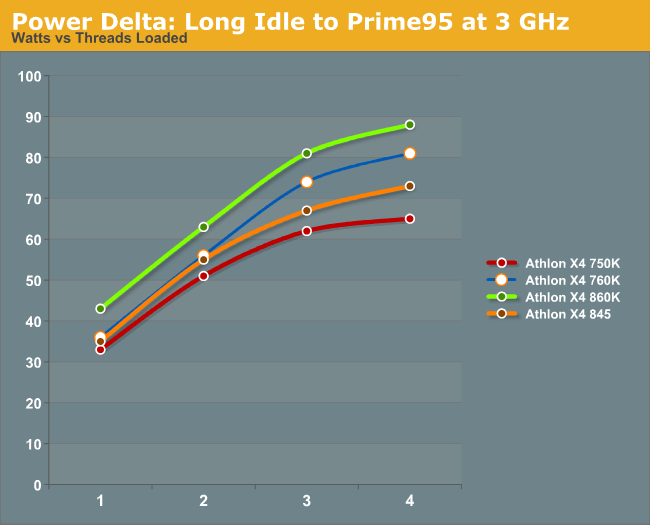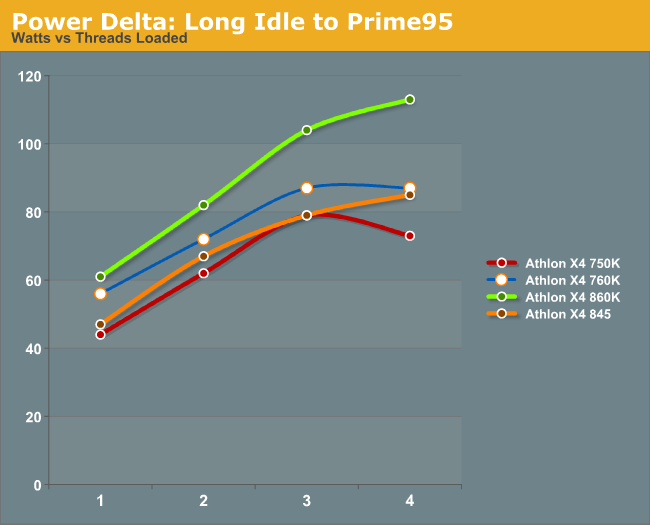AMD Carrizo Part 2: A Generational Deep Dive into the Athlon X4 845 at $70
by Ian Cutress on July 14, 2016 9:00 AM ESTPower Consumption
Power consumption was tested on the system while in a single MSI GTX 770 Lightning configuration with a wall meter connected to the power supply. This power supply is 80PLUS rated, and as I am in the UK on a 230-240 V supply, leads to ~75% efficiency > 50W, and 90%+ efficiency at 250W, suitable for both idle and multi-GPU loading. This method of power reading allows us to compare the power management of the UEFI and the board to supply components with power under load, and includes typical PSU losses due to efficiency.
Our Power Consumption tests have changed slightly since our last review as we are testing out new ways to represent the power used by the CPU and the system. The current three standard tests start with a system at long idle, meaning that the OS turns off the monitor and enters a lower power state without going into S3. We then move into a standard idle state on the desktop, with no software running but the desktop on display. The system is then moved into high performance mode, and we run a one-minute OCCT test to identify peak power consumption.
Due to extended requests, our power consumption numbers also use Prime95 to load the system. We use Prime95's peak power consumption mode, testing 1/2/3/4 thread consumption at the wall with our power meter. P95 hits the peak power relatively quickly, making this a straightforward test to include. For CPUs above 4 threads, we typically manage powers of two, half the CPU, and the full CPU to get an accurate picture.
For this review, we performed the power analysis for all four main CPUs at the 3 GHz frequency (using automatic voltage on the motherboard), as well as at stock frequencies. The values shown are delta values to the long idle power consumption, due to power delivery variations.
Generational Power Consumption at 3 GHz
All four processors have a 2-3W difference moving from a long idle to an idle state, however it is clear that our Carrizo CPU, which we stated is well outside its normal efficiency window at the beginning of this review, has a very good response during OCCT loading.

These results are within 3-4W of the full loading provided by Prime95 as well. If we analyze the per core jumps from moving up the threads using Prime95, there are some interesting numbers to pick out.

All the processors increase their power consumption by ~20W when both modules are loaded, when moving from 1 core loading to 2 core loading. When moving to 3/4 core loading, it is obvious that as both modules are already running at high frequency, a smaller amount of power is needed for each to enable the second thread.
Power Consumption at Stock
For those keeping track, we were not able to source identical TDP rated processors for this test. While the Carrizo based Athlon is 65W, the other processors are at the 95W/100W level. This makes total power consumption numbers relatively processional, and it becomes interesting looking into how close each processor gets to its TDP.
In our testing, the X4 845 seems to go beyond its 65W TDP, pushing almost another 9W through our power meter. This is only 8W away from the X4 750K, which should be 35W ahead. However, it would seem that for the X4 845, P95 draws an extra 15W compared to OCCT, but for the X4 750K, it draws 10W less, showing how difficult it can be to retain consistency. It is worth noting that TDP ratings are difficult to interpret in this way - the processors coming out of the fabs will have a statistical variation to their operating voltage, and this differs between samples. A good sample of a high TDP compared to a bad sample of a low TDP might seem to generate an interesting story, however without having access to several dozen units it can be strained to draw many conclusions.

Looking at the Prime95 core-loading numbers, we see a similar pattern to what happened at 3 GHz, despite the X4 760K getting the same power reading for 3/4 core loading and the X4 750K actually decreasing in power with four loaded threads.










131 Comments
View All Comments
artk2219 - Thursday, July 14, 2016 - link
They had too many parts that weren't hitting their mobile TDP's, or they just bakes too many chips than was needed on the mobile side. Either way, why let them sit in a warehouse or toss them at a loss, when for a very smalla mount you can just throw them into your standard desktop package and make some extra sales.TheinsanegamerN - Thursday, July 14, 2016 - link
Carrizo and kaveri did not use hypertransport. They would have to re-engineer their chip to work on AM3+, and to be frank, the AM3+ market is just too small to justify the tiny margins they would get.That money is better spent on getting zen out of the door.
neblogai - Thursday, July 14, 2016 - link
Why invest into upgrading bad product, when you can sell the same Bulldozer cores till Zen comes? And this Carriso Athlon is just a by-product of a mobile part and can only be sold for desktop. It all makes sense financially. By the way, new Bristol Ridge AMD 15W APUs are really nice and competitive, but laptop manufacturers are failing again- for example, HP Envy x360 comes with FX-9800P APU- again in single channel memory memory configuration, also with HDD installed and without possibility to use SSD. https://hardforum.com/threads/unboxing-1st-impress...TheinsanegamerN - Friday, July 15, 2016 - link
AMD doesnt take the mobile market seriously. If they did, they would be partnering up with the likes of MSI or clevo to produce a good laptop line for their APUs, or at the very least make dual channel a strict requirement.The_Countess - Tuesday, July 19, 2016 - link
AMD unfortunately can't demand much of anything from OEM's currently.and as intel still has a defacto monopoly no OEM wants to piss of intel by making a better AMD laptop.
nathanddrews - Thursday, July 14, 2016 - link
So... will there ever be a desktop Carrizo w/IGP? Much of the hype around Carrizo was focused on its very low power video playback, including H.265 hardware encode/decode.stardude82 - Thursday, July 14, 2016 - link
Isn't that what Bristol Ridge is? But on the new AM3 socket.Arnulf - Thursday, July 14, 2016 - link
AM4.Pissedoffyouth - Thursday, July 14, 2016 - link
Why not bang 8 of these cores into a 125w TDP and make it for FM2+ or AM3+? Finally an upgrade for Piledriver on AM3KAlmquist - Friday, July 15, 2016 - link
If you compare the Athlon 845 with the FX-4350 (link below), the Athlon wins on some benchmarks and loses on others. The Athlon has better IPC, but the FX has a faster clock and a 3rd level cache, leaving no clear-cut winner. If we added an L3 cache to the Athlon chip, that would speed it up, but not by a lot. In other words, Excavator is a big improvement over Piledriver in terms of performance per watt, but not much in terms of absolute performance. An Excavator based FX chip (by which I mean a chip with 8 Excavator cores and 8 MB of L3 cache) would probably be a very marginal improvement over the existing FX lineup at stock frequency, and would have less overclocking potential. I can see why AMD decided not to spend the resources to develop such a chip.http://www.anandtech.com/bench/product/1684?vs=127...